Related Research Articles

The IBM Personal Computer is the first microcomputer released in the IBM PC model line and the basis for the IBM PC compatible de facto standard. Released on August 12, 1981, it was created by a team of engineers and designers directed by Don Estridge in Boca Raton, Florida.

The Tandy 1000 is the first in a line of IBM PC workalike home computer systems produced by the Tandy Corporation for sale in its Radio Shack and Radio Shack Computer Center chains of stores.

The Amiga 2000, or A2000, is a personal computer released by Commodore in March 1987. It was introduced as a "big box" expandable variant of the Amiga 1000 but quickly redesigned to share most of its electronic components with the contemporary Amiga 500 for cost reduction. Expansion capabilities include two 3.5" drive bays and one 5.25" bay that could be used by a 5.25" floppy drive, a hard drive, or CD-ROM once they became available.

The Personal System/2 or PS/2 is IBM's second generation of personal computers. Released in 1987, it officially replaced the IBM PC, XT, AT, and PC Convertible in IBM's lineup. Many of the PS/2's innovations, such as the 16550 UART, 1440 KB 3.5-inch floppy disk format, 72-pin SIMMs, the PS/2 port, and the VGA video standard, went on to become standards in the broader PC market.

The TI-99/4 and TI-99/4A are home computers released by Texas Instruments in 1979 and 1981, respectively. Based on the Texas Instruments TMS9900 microprocessor originally used in minicomputers, the TI-99/4 was the first 16-bit home computer, and the associated video display controller provided color graphics and sprite support that was among the best of its era.
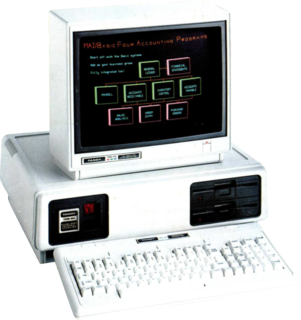
The Tandy 2000 is a personal computer introduced by Radio Shack in September 1983 based on the 8 MHz Intel 80186 microprocessor running MS-DOS. By comparison, the IBM PC XT used the older 4.77 MHz Intel 8088 processor, and the IBM PC/AT would later use the newer 6 MHz Intel 80286. Due to the 16-bit-wide data bus and more efficient instruction decoding of the 80186, the Tandy 2000 ran significantly faster than other PC compatibles, and slightly faster than the PC AT. The Tandy 2000 was the company's first computer built around an Intel x86 series microprocessor; previous models used the Zilog Z80 and Motorola 6809 CPUs.
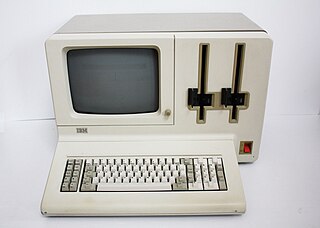
The System/23 Datamaster was announced by IBM in July 1981. The Datamaster was the least expensive IBM computer until the far less expensive and far more popular IBM PC was announced in the following month.
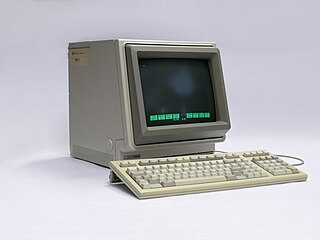
HP-150 was a compact, powerful and innovative computer made by Hewlett-Packard in 1983. It was based on the Intel 8088 CPU and was one of the world's earliest commercialized touch screen computers. Like other "workalike" IBM PC clones of the time, despite running customized MS-DOS versions 2.01, 2.11 and 3.20, the machine was not IBM PC DOS compatible. Its 8088 CPU, rated at 8 MHz, was faster than the 4.77 MHz CPUs used by the IBM PC of that period. Using add-on cards, main memory could be increased from 256 KB to 640 KB. However, its mainboard did not have a slot for the optional Intel 8087 math coprocessor due to space constraints. An HP-150 with an optional hard disk was called HP Touchscreen MAX.
The Apricot PC was a personal computer produced by Apricot Computers, then still known as Applied Computer Techniques or ACT. Released in late 1983, it was ACT's first independently developed microcomputer, following on from the company's role of marketing and selling the ACT Sirius 1, and was described as "the first 16-bit system to be Sirius-compatible, rather than IBM-compatible", indicating the influence that the Sirius 1 had in the United Kingdom at the time.

The IBM 3270 PC, released in October 1983, is an IBM PC XT containing additional hardware that, in combination with software, can emulate the behaviour of an IBM 3270 terminal. It can therefore be used both as a standalone computer, and as a terminal to a mainframe.

DECmate was the name of a series of PDP-8-compatible computers produced by the Digital Equipment Corporation in the late 1970s and early 1980s. All of the models used an Intersil 6100 or Harris 6120 microprocessor which emulated the 12-bit DEC PDP-8 CPU. They were text-only and used the OS/78 or OS/278 operating systems, which were extensions of OS/8 for the PDP-8. Aimed at the word processing market, they typically ran the WPS-8 word-processing program. Later models optionally had Intel 8080 or Z80 microprocessors which allowed them to run CP/M. The range was a development of the VT78 which was introduced in July 1977.
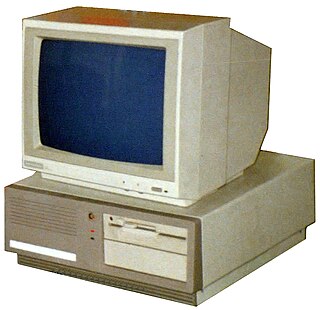
The Commodore PC compatible systems are a range of IBM PC compatible personal computers introduced in 1984 by home computer manufacturer Commodore Business Machines.

The history of the personal computer as a mass-market consumer electronic device began with the microcomputer revolution of the 1970s. A personal computer is one intended for interactive individual use, as opposed to a mainframe computer where the end user's requests are filtered through operating staff, or a time-sharing system in which one large processor is shared by many individuals. After the development of the microprocessor, individual personal computers were low enough in cost that they eventually became affordable consumer goods. Early personal computers – generally called microcomputers – were sold often in electronic kit form and in limited numbers, and were of interest mostly to hobbyists and technicians.

The history of laptops describes the efforts, begun in the 1970s, to build small, portable personal computers that combine the components, inputs, outputs and capabilities of a desktop computer in a small chassis.

The IBM Personal Computer XT is the second computer in the IBM Personal Computer line, released on March 8, 1983. Except for the addition of a built-in hard drive and extra expansion slots, it is very similar to the original IBM PC model 5150 from 1981.
The Texas Instruments Portable Professional Computer (TIPPC) was a portable version of Texas Instruments Professional Computer (TIPC), and were devices that were both released on January 31, 1983. The TIPC was a desktop PC and the TIPPC was a fully compatible, portable version of the TIPC, and both machines were DOS-compatible, but not an IBM PC compatible. Both computers were most often used by white-collar information workers and professionals who needed to gather, manipulate and transmit information. Texas Instruments (TI) was the first company to release videotape training videos for their computers.

The Olivetti M20 is a Zilog Z8000 based computer designed and released by Olivetti in 1982. Although it offered good performance, it suffered from a lack of software due to its use of the Z8000 processor and custom operating system, PCOS. The company introduced the IBM PC compatible Olivetti M24 in 1983 and the M20 line was phased out.

The West PC-800 is a home computer introduced by Norwegian company West Computer AS in 1984. The computer was designed as an alarm center allowing use of several CPUs and operating systems. The company introduced an IBM PC compatible in early 1986 and the West PC-800 line was phased out.
Toshiba Pasopia 16 or PA7020 is a IBM PC compatible computer from manufacturer Toshiba, released in 1982 and based around a Intel 8088-2 microprocessor running at 6 MHz. It's also known as T300 on the US and PAP in Europe.
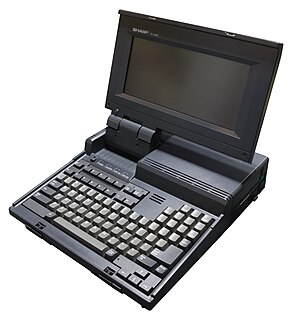
The Sharp PC-4500 is a line of laptop computers released by Sharp Corporation in 1987. The line comprises the PC-4501, the PC-4502, and the PC-4521. The PC-4501 is a bare-bones unit with only 256 KB of RAM stock, only one floppy drive, no backlighting, and no built-in numeric keypad; the PC-4502 and PC-4521 bumps the stock RAM to 640 KB and includes the latter two features while providing either two floppy drive (PC-4502) or one floppy drive and a 20 MB hard drive (PC-4521). Prices on the line initially ranged from $1,295 to just under $3,000; the PC-4501 was later sold for $995, becoming one of the first sub-$1,000 laptops available on the market. The PC-4500 line received mixed, mostly positive, reviews on its release in September 1987.
References
- 1 2 3 4 5 6 7 8 9 "Texas Instruments Professional Computer" (PDF). Texas Instruments. 1983. Retrieved November 4, 2021– via Classic Computer Brochures.
- 1 2 3 4 5 Haas, Mark (December 1983). "The Texas Instruments Professional Computer – Daring to be somewhat different". Byte . Vol. 8, no. 12. Peterborough NH: McGraw-Hill. pp. 286–324. Retrieved November 4, 2021.
- 1 2 Knight, Daniel (December 19, 2015). "Texas Instruments' Personal Computers". LowEndMac. Retrieved November 4, 2021.